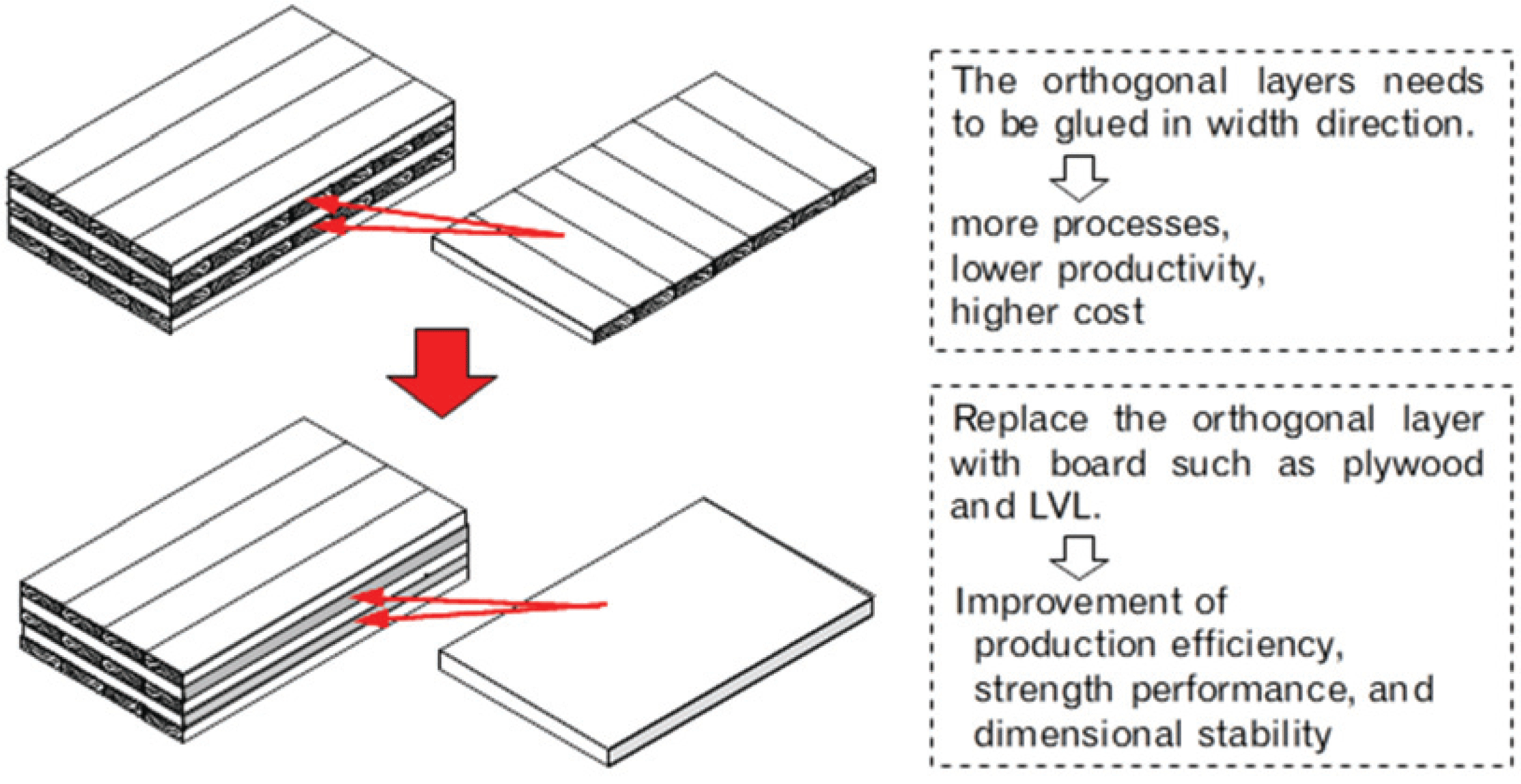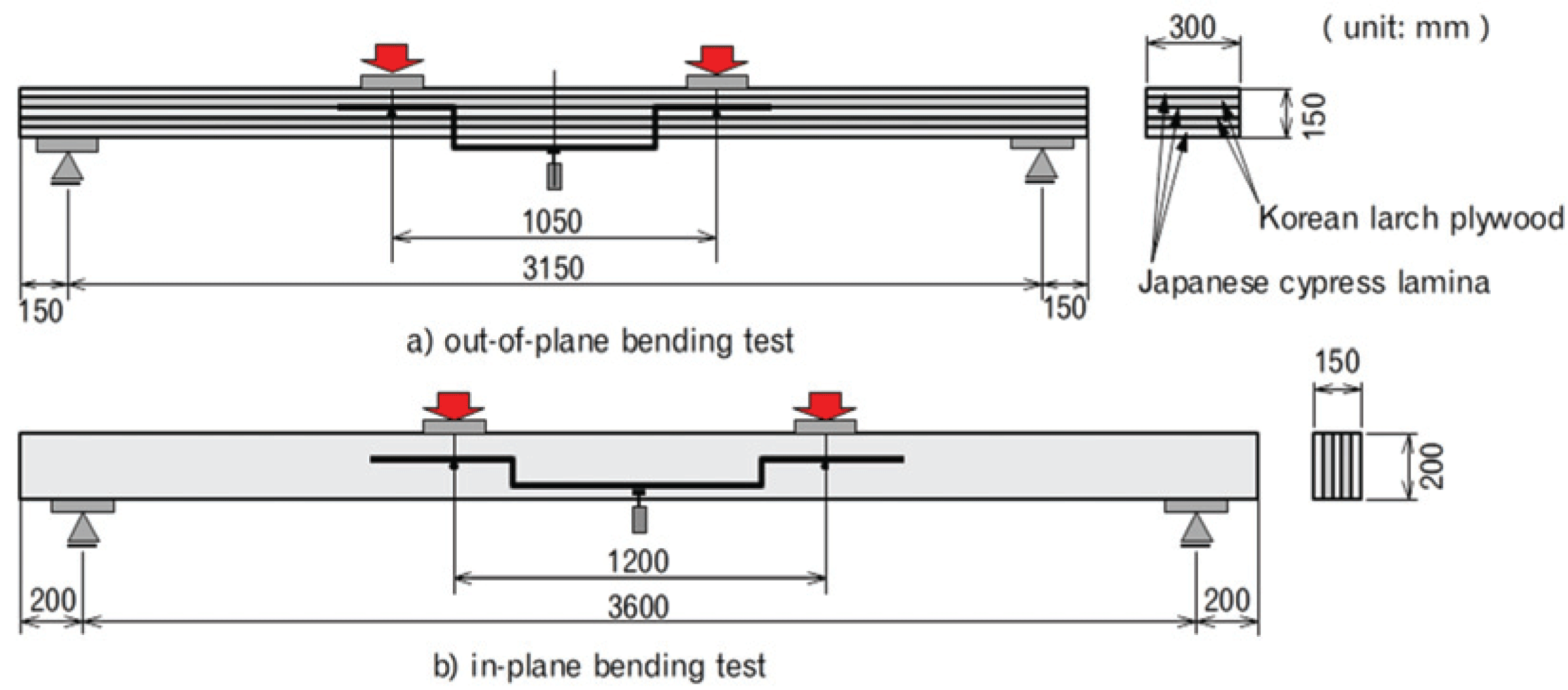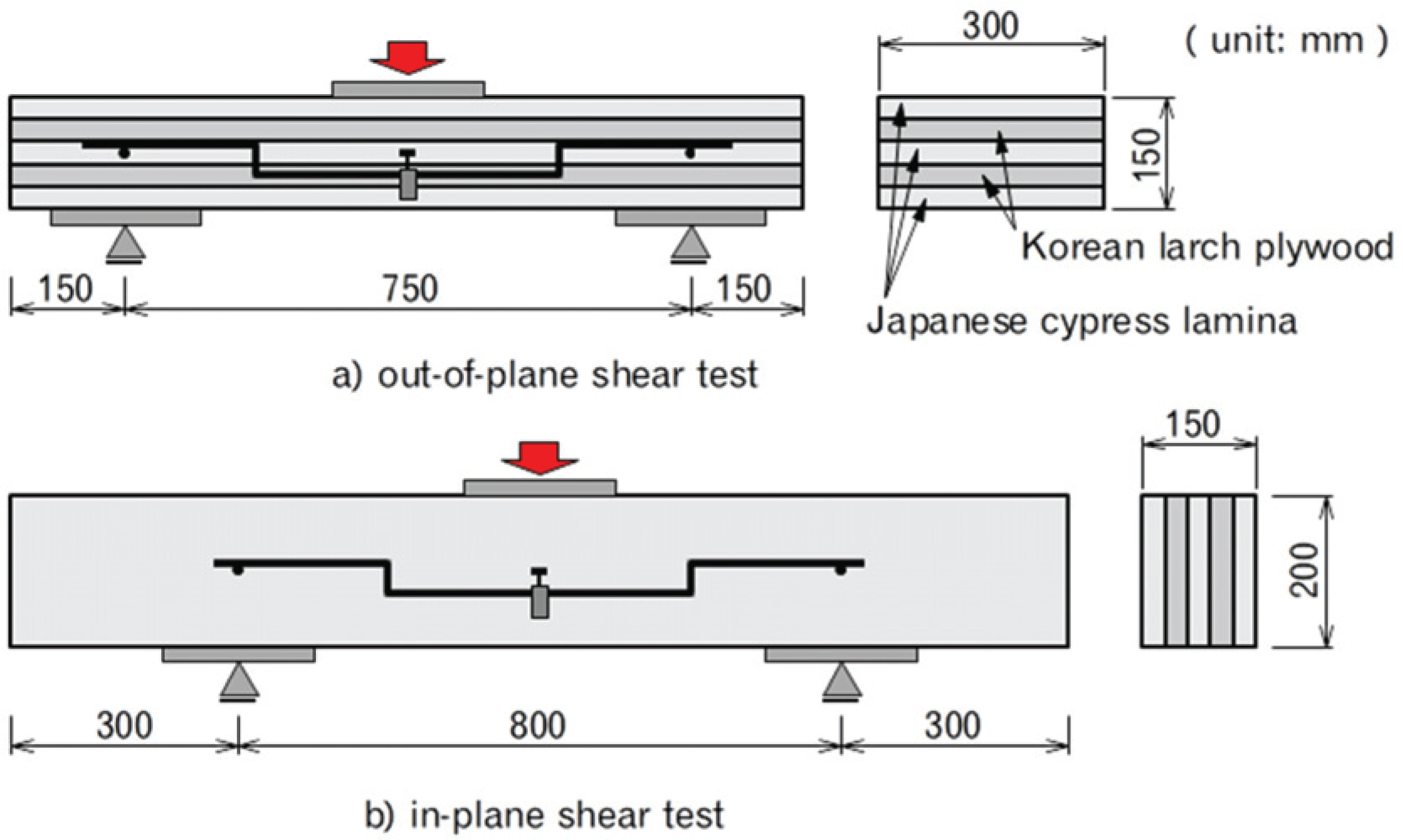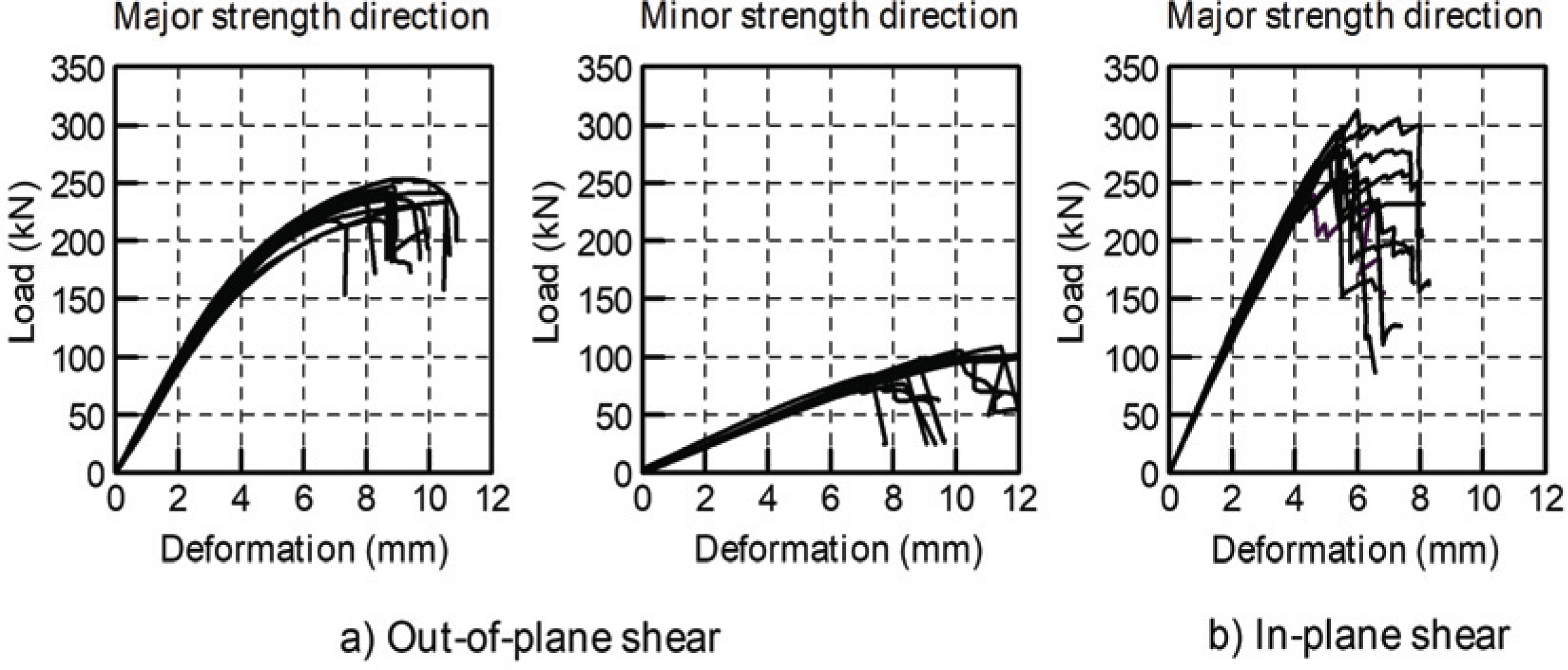1. INTRODUCTION
In recent years, the production volume of crosslaminated timber (CLT) has increased rapidly in countries around the world, mainly in Europe and the United States, and it was estimated that the global production of CLT would reach approximately 1 million m3 in 2018 (Schickhofer, 2017). CLT is expected to continue to increase in popularity because it has many advantages, such as the ability to use it to construct mid- and high-rise buildings made of wood, the reduced transportation and construction costs due to its light weight, and its high heat insulation value. Research is being conducted on improving the strength performance, lateral resistance of wall panels, connection of walls, sound performance, and fire resistance performance of CLT (Choi et al., 2018; Jang et al., 2019; Jung et al., 2020; Kang et al., 2019).
In Japan, CLT production is currently 14,000 m3 per year (Japan Forestry Agency, 2017), which represents only 1.6% of the global production of 885,000 m3 in 2017 and is extremely low compared to Europe and America. However, CLT is expected to be widely used in the future if public-private efforts such as the establishment of Japanese Agricultural Standards (JAS) for CLT in 2013 and the maintenance of CLT building design methods are taken into consideration in addition to the advantages of CLT. As of January 2018, there are seven JAS-certified CLT plants in Japan, but only one plant uses the type of advanced automation line found in Europe. The productivity of these plants is low compared to European facilities, in part because most factories produce CLT by laminating the laminae with the edges glued together in the width direction. If the production process in Japan is not improved, the production cost will not decrease, and even if CLT grows in popularity as a building material in Japan, the main source is likely to be imported CLT from overseas. Therefore, prior to the widespread adoption of full-scale CLT buildings, it is desirable to develop a new CLT manufacturing process that increases production efficiency, reduces costs, and uses local materials that have sufficient strength performance.
Overseas, new types of CLT in which wood-based materials such as laminated veneer lumber (LVL), LSL, and OSB are mixed and laminated are being developed (Wang et al., 2017; Davuds et al., 2017; Nurdiansyah et al., 2020). In Korea, CLT that incorporates structural plywood, referred to as ply-lam CLT, has been developed to improve the yield and strength performance. It is difficult to secure laminae of domestic wood for structural use at low cost in Korea because much of the domestic timber supply consists of short wood and small and medium-sized wood. Under these circumstances (and because plywood manufacturing is one of the major timber industries in Korea, the production yield is high and kiln drying is easy), plywood is attracting attention as a suitable use for Korean wood. Therefore, the practical application of a new wood-based CLT panel in which imported structural lumber is utilized in the parallel layers (outer and inner layers) and Korean larch plywood is utilized for the orthogonal layers is being studied (Choi et al., 2015; Choi et al.,2018). Research on the strength performance, insulation value and building energy requirement of Ply-lam CLT is ongoing (Chang et al., 2019; Chang et al., 2020; Choi et al., 2020; Pang et al., 2019).
Therefore, in this study, a new material, Ply-lam, is developed by utilizing wood-based panels such as LVL or plywood for the orthogonal layers in the CLT layer structure in order to simplify the manufacturing process, improve productivity, reduce variations in product performance and improve product quality, as shown in Fig. 1. Ply-lam can be manufactured even at a CLT factory that does not have an advanced production line as long as it has a press capable of producing large-format products (1000 mm width, 3000 to 4000 mm length).
Here, the results are reported for full-scale bending and shear tests of Ply-lam made by alternately laminating edge-glued Japanese cypress lamina and Korean larch plywood.
2. MATERIALS and METHODS
Japanese cypress (Chamaecyparis obtusa) laminae from south part of Kyushu islands were used for the parallel layer of Ply-lam. The laminae with width of 120 mm were graded by mechanical stress grading machine. The laminae with Young’s modulus (MOE) of 11 kN/mm2 or higher were used for outer layer of Ply-lam and with 9 kN/mm2 or lower laminae were used for inner layer. The density and moisture content of Japanese cypress laminae was 496 kg/m3 and 10%, respectively. The laminae were edgewise glued with aqueous polymer-isocyanate (API) resin adhesive using high-frequency hot press into panels with the size of 1000 × 30 × 4000 mm (W × D × L).
Plywood made from Korean larch (Larix kaempfer i) was used for the orthogonal layer of Ply-lam. Eleven-ply plywood panels of 1220 × 30 × 2440 mm (W × D × L) were manufactured at a plywood factory in Korea. The plywood was composed of veneers of equal thickness, and phenol-formaldehyde resin was used for adhesion.
Most plywood manufactured in Korea is made of imported wood, and thus there is almost no strength data available for Korean larch plywood. For that reason, and because the plywood used in this study was manufactured with a special layer structure using an equal-thickness veneer, the bending and shearing performance of the Korean larch plywood was evaluated.
After measuring the density of 25 plywood plates, small test specimens were taken from one of them, and an out-of-plane bending test (4-point loading method, total span 36D: 36 times the specimen depth) and out-of-plane shearing test (3-point bending method, full span 4D) were performed using a universal testing machine (Shimadzu Corporation, Type AG- 100kNI). The specimen dimensions were 200 × 30 × 1200 mm (W × D × L) for the bending test (number of specimens: 6 each in the major and minor strength directions) and 40 × 30 × 180 mm (W × D × L) for the shear test (number of specimens: 12 in the major strength direction only).
The density of the Korean larch plywood was 645 kg/m3 with a standard deviation of 31.3 kg/m3, which is higher than the typical value for Japanese larch. The bending test resulted in an average and standard deviation of MOE in the major and minor strength directions of 10.9 and 0.948 kN/mm2 and 5.19 and 0.382 kN/mm2, respectively. The ratio of MOE in the minor/ major strength directions was 0.48. As for the bending strength, the average and standard deviation of bending strength (MOR) in the major and minor strength directions was 44.1 and 2.76 N/mm2 and 18.70 and 2.07 N/mm2, respectively. The ratio of MOR in the minor/major strength directions was 0.42. These values were sufficient to satisfy the JAS strength grade E80-F270 standards for plywood (JAS 303 2014).
In the shear test, a large amount of indentation was observed at the loading point, many shear-bending composite fractures were observed, and horizontal shear fracture due to rolling shear occurred in all of the specimens. The average and standard deviation of shear strength were 3.51 and 0.328 N/mm2, respectively.
The edge-glued Japanese cypress panels manufactured in Japan were exported to a CLT manufacturing plant in Korea, and 15 Ply-lam original plates with a size of 1000 × 150 × 4000 mm (W × D × L) were manufactured. The cross-sectional structure was a 5-ply structure in which parallel layers of cypress were laminated alternately with Korean larch plywood. For the plywood, two plywood panels cut into lengths of 2400 and 1600 mm (both widths were 1000 mm) were arranged side by side so that the fiber direction of the plywood surface was parallel to the fiber direction of the cypress panel. At that time, the end joint of the plywood was not glued. In order to stagger the position of the butt joint in the length direction in the second and fourth plywood layers of the Ply-lam, the two plywood panels of different lengths were arranged in opposite positions in the two layers. The Ply-lam was manufactured using resorcinol resin adhesive and a pressure of 1 MPa for 12 hours or more in a cold press with a platen size of 1100 by 4800 mm.
As a performance evaluation of the manufactured Ply-lam, tests of out-of-plane bending (FWB), in-plane bending (EWB), out-of-plane shearing in the major strength direction (FWSma) and the minor strength direction (FWSmi) and in-plane shearing in the major strength direction (EWS) were carried out. “Major” denotes the general direction of the grain, wherein the outer layer is parallel to the length of the CLT. On the other hand, “minor” indicates the general direction of the grain, wherein the outer layer is perpendicular to the length of the CLT. The sizes of the specimens and the methods used for these tests are shown in Table 1.
Twelve out-of-plane bending test specimens with the size of 300 × 150 × 3450 mm (W × D × L) and 12 in-plane bending test specimens with the size of 150 × 200 × 4000 mm (W × D × L) (all in the major strength direction, see Fig. 2) were sampled from the Ply-lam original plate.
First, the dynamic Young's modulus was measured by the axial vibration method and the flexural vibration method according to the Structural Wood Strength Test Manual of Japan Housing and Wood Technology Center (HOWTEC). The axial Young's modulus (Efr) was calculated from the natural vibration of the specimen using Equation (1) (HOWTEC 2011).
Here f: Resonance frequency (primary resonance frequency) (Hz), ρ: density (kg/m3), L: length (m) of specimen.
The apparent dynamic bending Young's modulus including the effect of shear deflection (Eafb) was calculated using Equation (2) from the natural bending frequency and density of the specimen supported by the cushion (free beams at both ends) (HOWTEC 2011).
Here, f1: Primary bending natural frequency (Hz), ρ: density (kg/m3), L: length (m) of specimen. i: radius of gyration of area (
The test conditions of the bending tests are shown in Fig. 2. The out-of-plane bending test was conducted using the three-division point four-point loading method (total span: 21D) according to the JAS for CLT (JAS 3079 2019). The in-plane bending test was conducted using the three-division point four-point loading method (total span: 18D) according to the test method of HOWTEC (HOWTEC 2011). Both bending tests were conducted at the loading speed of 10 mm/min using a full-scale strength testing machine (Tokyo Koki Co., Ltd., Type WU-1000/TK21). Displacement transducers were used to measure both the total span deflection (Tokyo Measuring Instruments Laboratory Co., Ltd., SDP-200D) and the deflection in a part of constant moment (Tokyo Measuring Instruments Laboratory Co., Ltd., CDP-25). The bending strength (MOR), the apparent bending Young's modulus including shear effect (MOEm) and true bending Young's modulus (MOEb) were calculated using Equation (3), (4) and (5), respectively (HOWTEC 2011).
Here, a: Distance from the fulcrum to the loading point (m), Pmax: Maximum load (N), Z: Section modulus (m3), l: span (m), P2-P1: increment of load in the proportional range of the load deformation curve (N), P1 and P2 is approximately 10% and 40% of Pmax, est (estimated maximum load), respectively, w2-w1: deformation increment corresponding to P2-P1, I: moment of inertia of area (m4), ld: length of displacement measurement section between load points (m).
The moisture content during the test was approximately 8% (Japanese cypress lamina: approximately 10%, Korean larch plywood: approximately 7%), and the test time until failure was approximately 6 minutes in the out-of-plane bending test and 5 minutes in the in-plane bending test.
From a Ply-lam original plate, the specimen with dimensions of 300 × 150 × 1050 mm (W × D × L) were sampled for the out-of-plane shear test (major and minor strength direction). The number of specimen was 12 for each direction. Another eleven specimens with the size of 150 × 200 ×1400 mm (W × D × L) were sampled for the in-plane shear test (major strength direction only).
After measuring the dynamic modulus of elasticity (Efr) by the axial vibration method, a shear test was performed with a full-scale strength testing machine using the central concentrated load method according to the JAS for CLT (JAS 3079 2019) and the test method of HOWTEC (HOWTEC 2011).
The test conditions of the shear test are shown in Fig. 3. The span was 5 times time specimen depth in the out-of-plane shear test and 4 times the depth in the in-plane shear test. The deflection at the center of the span was measured using a yoke attached to a displacement transducer (Tokyo Measuring Instruments Laboratory Co., Ltd., CDP-50M) so that the embedding displacements of specimens at the support were not included. The width of the loading block was 200 mm for both the support part and the center loading part. The loading speed was 2 mm/min, and the load was applied until the load dropped below 80% of the maximum load. The moisture content during the test was approximately 9% (Japanese cypress lamina: approximately 10%, Korean larch plywood: approximately 8%), and the test time until failure was approximately 5 minutes in the out-of-plane shear test and 3 minutes in the in-plane shear test.
From the maximum load obtained in the test, the shear strength (fs) was calculated by Equation (6). For the major strength direction specimen, the shear modulus (G) was calculated from Equation (7) based on the load-deflection relationship in the proportional range according to the test method of HOWTEC (HOWTEC 2011).
Here Pmax: maximum load (N), W: width of specimen (m), D: depth of specimen (m), l: span (m), ΔP/Δδ: load per unit displacement in the proportional range, MOEb: true bending Young's modulus (refer to Table 2).
3. RESULTS and DISCUSSION
The density of the test specimen and the results of the bending tests are shown in Table 2. The average density of Ply-lam was 571 kg/m3, which was approximately 11% lower than that of Korean larch plywood. The MOE values of the test specimen had little variation. Regarding the dynamic MOE, the MOE value determined by the axial vibration method (Efr) were intermediate between the MOE values obtained via the flexural vibration method (Eafb) in the out-of-plane and in-plane directions. The MOEm of out-of-plane and in-plane bending were in good agreement with the Eafb in out-of-plane and in-plane bending, respectively.
The MOEm of out-of-plane bending agrees well with the calculated value obtained by the equivalent cross-section method based on the MOE value of lamina and plywood. In addition, the observed MOEm values were 16% higher for out-of-plane bending and 86% higher for in-plane bending than the standard value for strength grade Mx120-5-5 in JAS for CLT (JAS 3079 2019). It is likely that the use of plywood as the orthogonal layers of the CLT had a great influence on these results.
Regarding the fracture of out-of-plane and in-plane bending, after the crush on the compression side, the fracture mainly occurred from the defect on the tensile side. Initial compressive failure occurred in the lamina near the but-jointed part of the plywood on the compression side of in-plane bending, but the relationship between the locations of the but joint and the tensile fracture was not clear.
For MOR, the 5% lower limit, which is the statistical "95% lower permissible limit at a confidence level of 75%", was calculated using Equation (8) (HOWTEC 2011).
Here, F: 5% lower limit value, x: mean value, K: coefficient corresponding to the number of specimens, s: sample standard deviation. The K values of 2.048, 2.074 and 2.104 were used depending on the number of specimens of 10, 11 and 12, respectively, in this study.
The MOR value was higher for out-of-plane bending than for in-plane bending, and the 5% lower limit value were 39.6 N/mm2 for out-of-plane bending and 32.6 N/mm2 for in-plane bending. These results are much higher than the standard strengths for strength grade Mx120-5-5 (out-of-plane bending 16.0 N/mm2, in-plane bending 11.3 N/mm2) (Ministry of Land, Infrastructure, Transport and Tourism of Japan 2018).
The results of the shear test are shown in Table 3, and the relationship between the load and the displacement in each shear test is shown in Fig. 4. In the out-of-plane shear test in the major strength direction, plastic deformation was observed at the load beyond the proportional limit. The fracture type in all specimens was rolling shear of the plywood that constitutes the second or fourth layer of the Ply-lam. Since the failure occurred at the plywood, the ruptured position was away from the neutral axis. However, the 5% lower limit value of fs calculated by equation (8) was about 3 times the strength standard of CLT, which is 1.2 N/mm2 for cypress and larch (Ministry of Land, Infrastructure, Transport and Tourism of Japan 2018).
In the out-of-plane shear test in minor strength direction, when the load reached at 70% to 80% of the maximum load, damage occurred at the edge-jointed portion of the outer layer lamina on the tensile side. Five of the 12 specimens finally fractured due to bending, while the other specimens were dominated by shear failure (rolling shear) of the inner layer lamina with the neutral axis. However, shear failure of plywood occurred on the extension line of the shear failure plane almost simultaneously with the shear failure of lamina, and the load-displacement relationship showed brittle behavior. In the in-plane shear test in major strength direction, 2 out of 11 specimens failed due to bending, while the other test specimens showed a composite fracture mode in which shear failure occurred in the lamina after tensile failure caused by breakage on the tensile side of the lamina occurred. The 5% lower limit value of fs was about twice the strength standard for CLT of 2.9 N/mm2 (Ministry of Land, Infrastructure, Transport and Tourism of Japan 2018).
Comparing the shear properties in major strength direction, the fs and G of in-plane shear was approx. 1.6 times and 3 times those of out-of-plane shear, respectively. This is probably because the shearing performance of plywood differs depending on the direction in which the shear force acts.
4. CONCLUSION
CLT that uses wood-based panels as the orthogonal layers was developed in this study for purpose of improving the productivity and quality of CLT. This time, Ply-lam which is a kind of CLT using Japanese cypress lamina for parallel layer and Korean larch plywood for orthogonal layer is manufactured, and the results of bending test and shearing test are described.
The MOEm of the out-of-plane and in-plane bending obtained by the bending test was in good agreement with the Eafb obtained by flexural vibration method in the out-of-plane and in-plane directions. The MOEm of out-of-plane bending was also in good agreement with the calculated value obtained by the equivalent cross-section method based on the MOE values of the lamina and plywood components. Regarding the MOE, it is considered that there is a high potential for strength design based on layer construction and strength evaluation using a non-destructive test method.
Comparing the measured MOE with the value of the standard for strength class Mx120-5-5 in JAS for CLT, the measured MOE values for out-of-plane and in-plane bending were 16% and 86% higher than the standards, respectively. Also, the 5% lower limit values of the MOR for out-of-plane bending and in-plane bending were 39.6 and 32.6 N/mm2, respectively. Comparing these values with those of the standard for strength class Mx120-5-5 in JAS for CLT, the MOR of Ply-lam was again much higher than the regulatory strength.
Regarding the shear performance, the lower limit of shear strength was about twice the JAS strength standard for CLT (2.9 N/mm2). From these facts, it was confirmed that Ply-lam constructed using plywood as orthogonal layers exhibits greatly improved strength performance. The practicability of its use as a structural material was also confirmed.




